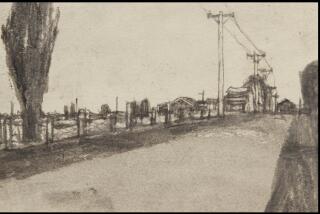Winslow Homerâs range and depth
WILLIAMSTOWN, Mass. â He was as adept at drawing a charging brigade of Civil War soldiers as he was at painting outdoorsmen scouting a mountaintop view in the Adirondacks.
And the seascapes illustrated from his vantage point on the rocky Maine coast captured an uneasy balance between the violence of white-capped waves and the tranquillity of a sunrise over the Atlanticâs horizon.
Winslow Homer was a chronicler of American times and a recorder of the countryâs landscapes, a mostly self-taught artist who did not have to wait for a posthumous nod from critics and collectors, who called him one of the most important artists of the 19th century.
A sweeping exhibit of Homerâs works on display through Jan. 16 at the Clark Art Institute showcases the artistâs diversity of subjects and the mediums he chose to illustrate them.
âWinslow Homer: Making Art, Making Historyâ displays about 170 works from the Clarkâs extensive collection of Homerâs engravings, etchings, watercolors and oil paintings, collected by Robert Sterling Clark between 1916 and 1955. The show will not travel elsewhere.
âIn all these realms, he achieved not only the highest levels of quality, but he altered what it meant to work in these mediums,â said Marc Simpson, the Clarkâs curator of American art.
The wood engravings he did as a freelancer for magazines such as Harperâs Weekly cast the mass-produced images as works of fine art. The works marked the start of the Boston nativeâs career as an artist and display his talent of being able to create realistic scenes from his imagination.
Although he was often commissioned to illustrate Civil War battle scenes, he never witnessed a confrontation between Union and Confederate soldiers. Not all his journalistic work focused on the war. Several prints from his wood engraving drawings show the pleasant and bucolic side of America, with men and women gathered at social engagements and lumberjacks working on a winter day.
Homer started painting with oils when the war ended, and his works in the late 1860s and 1870s reflect a shift in the countryâs focus from the ravages of war to the escapism of leisure activities.
He found plenty of inspiration in the mountains of the Northeast, where he painted a woman on horseback at the top of New Hampshireâs Mt. Washington and a pair of woodsmen stopping along an Adirondack trail.
Homerâs compositions draw the viewer in to see things from his subjectâs perspective.
In âTwo Guides,â Homerâs outdoorsmen stand at the center of the canvas. A glint of light reflects from the older manâs ax blade, first attracting the viewerâs eye and then leading it to follow the guideâs outstretched hand and the gaze of his younger companion.
But the painting leaves one nagging question: What are they observing?
In 1873, Homer began using watercolors, a medium that gave his work a looser feel. In âAn October Day,â he frames a deer swimming across a lake with the glowing colors of fallâs foliage reflecting off the water.
âHeâs letting serendipity work its way throughout the image,â Simpson said.
Homer also tried his hand at etchings, doing some of the work of which he was most proud. But after devoting most of his time to the medium, after two years he stopped doing etchings because they werenât selling.
By the mid-1880s, Homer had moved to Prouts Neck in Maine and produced some of the nautical images with which heâs most commonly associated.
In âWest Point, Proutâs Neck,â Homerâs sea splashes in the foreground as the sun casts a blaze of orange over the horizon.
The Clarkâs exhibit spans the shifts in Homerâs work, but it also captures the museum founderâs fascination with the artist. Clark began collecting Homerâs illustrations in 1916, six years after the artist died. He acquired more than 200 of Homerâs works.
More to Read
The biggest entertainment stories
Get our big stories about Hollywood, film, television, music, arts, culture and more right in your inbox as soon as they publish.
You may occasionally receive promotional content from the Los Angeles Times.









